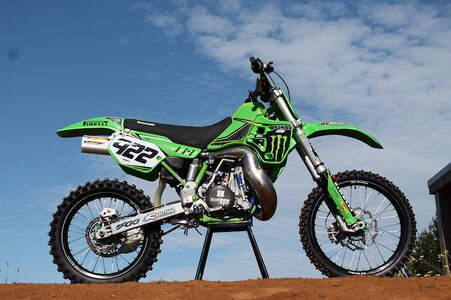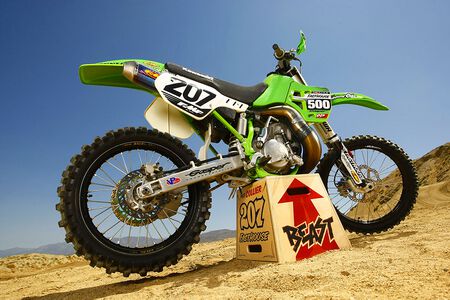Difference between revisions of "Kawasaki KX500"
m |
m |
||
| (4 intermediate revisions by the same user not shown) | |||
| Line 1: | Line 1: | ||
{{DISPLAYTITLE: Kawasaki KX500}} | {{DISPLAYTITLE: Kawasaki KX500}} | ||
| + | {{#seo: | ||
| + | |keywords={{PAGENAME}}, review, specs, owners manual, service manual, guide | ||
| + | |og:image=https://en.enduro.team/images/5/5f/Kx500.jpg | ||
| + | }} | ||
__notoc__ | __notoc__ | ||
| − | [[file: Kx500.jpg | | + | [[file: Kx500.jpg | 600px | center]] |
| − | + | ''' Kawasaki KX 500 ''' motocross model was first introduced in 1983 to compete in motocross in the class of 2-stroke motorcycles with an engine capacity of up to 500 cc. | |
{{Ads_top}} | {{Ads_top}} | ||
| + | |||
| + | '''Lineup:''' | ||
| + | * [[Kawasaki_KX85 | Kawasaki KX85]] | ||
| + | * [[Kawasaki_KX125 | Kawasaki KX125]] | ||
| + | * [[Kawasaki_KX250 | Kawasaki KX250]] | ||
| + | * [[Kawasaki_KX500 | Kawasaki KX500]] | ||
| + | |||
| + | ''' Main competitors: ''' | ||
| + | * [[Honda_CR500 | Honda CR500]] | ||
| + | |||
However, the first versions of the Kawasaki KX 500 were not very successful, and therefore did not bring victories in official competitions. The situation began to change only in 1986, when Donnie Griewe won the National Hare and Hound race using the KX500 motorcycle. In 1989, Kawasaki wins the National MX Championship, repeating this achievement in 1990 and 1992. - until the closure of the official racing series of the 500 cm³ class. After the disappearance of 500cc motorcycles from official motocross programs, many of the then models found themselves in desert racing, and the Kawasaki KX500 again became a triumphant - from 1992 to 1995. he won every Desert Nationals race, and after the championship was renamed the Desert Nationals Championship, he became the permanent winner until 2001. | However, the first versions of the Kawasaki KX 500 were not very successful, and therefore did not bring victories in official competitions. The situation began to change only in 1986, when Donnie Griewe won the National Hare and Hound race using the KX500 motorcycle. In 1989, Kawasaki wins the National MX Championship, repeating this achievement in 1990 and 1992. - until the closure of the official racing series of the 500 cm³ class. After the disappearance of 500cc motorcycles from official motocross programs, many of the then models found themselves in desert racing, and the Kawasaki KX500 again became a triumphant - from 1992 to 1995. he won every Desert Nationals race, and after the championship was renamed the Desert Nationals Championship, he became the permanent winner until 2001. | ||
The first versions of the Kawasaki KX500 were built on the basis of a 1-cylinder 2-stroke air-cooled engine with a volume of 499 cm³, which was subsequently replaced by a liquid engine. From that moment on, the model became close in characteristics to competitors and began to win trophies. | The first versions of the Kawasaki KX500 were built on the basis of a 1-cylinder 2-stroke air-cooled engine with a volume of 499 cm³, which was subsequently replaced by a liquid engine. From that moment on, the model became close in characteristics to competitors and began to win trophies. | ||
| − | '' | + | ''' Generations: ''' |
* '''Kawasaki KX500 (1983-1984)''' - first generation. The model features an air-cooled engine with a reduced compression ratio. | * '''Kawasaki KX500 (1983-1984)''' - first generation. The model features an air-cooled engine with a reduced compression ratio. | ||
* '''Kawasaki KX500 (1985-1986)''' - second generation. The model gets a completely new liquid-cooled engine and progressive suspensions. | * '''Kawasaki KX500 (1985-1986)''' - second generation. The model gets a completely new liquid-cooled engine and progressive suspensions. | ||
| Line 18: | Line 32: | ||
The Kawasaki KX500 was produced until 2004, after which it was finally discontinued, giving way to the 4-stroke version - [[Kawasaki_KX450F | Kawasaki KX450F]]. The withdrawal from the market of 500cc 2-stroke motocross models was due to the closure of the corresponding open class in motocross and the subsequent decrease in demand for the models. | The Kawasaki KX500 was produced until 2004, after which it was finally discontinued, giving way to the 4-stroke version - [[Kawasaki_KX450F | Kawasaki KX450F]]. The withdrawal from the market of 500cc 2-stroke motocross models was due to the closure of the corresponding open class in motocross and the subsequent decrease in demand for the models. | ||
| − | |||
| − | |||
| − | |||
== Photos == | == Photos == | ||
Latest revision as of 16:49, 10 July 2023
Kawasaki KX 500 motocross model was first introduced in 1983 to compete in motocross in the class of 2-stroke motorcycles with an engine capacity of up to 500 cc.
Lineup:
Main competitors:
However, the first versions of the Kawasaki KX 500 were not very successful, and therefore did not bring victories in official competitions. The situation began to change only in 1986, when Donnie Griewe won the National Hare and Hound race using the KX500 motorcycle. In 1989, Kawasaki wins the National MX Championship, repeating this achievement in 1990 and 1992. - until the closure of the official racing series of the 500 cm³ class. After the disappearance of 500cc motorcycles from official motocross programs, many of the then models found themselves in desert racing, and the Kawasaki KX500 again became a triumphant - from 1992 to 1995. he won every Desert Nationals race, and after the championship was renamed the Desert Nationals Championship, he became the permanent winner until 2001.
The first versions of the Kawasaki KX500 were built on the basis of a 1-cylinder 2-stroke air-cooled engine with a volume of 499 cm³, which was subsequently replaced by a liquid engine. From that moment on, the model became close in characteristics to competitors and began to win trophies.
Generations:
- Kawasaki KX500 (1983-1984) - first generation. The model features an air-cooled engine with a reduced compression ratio.
- Kawasaki KX500 (1985-1986) - second generation. The model gets a completely new liquid-cooled engine and progressive suspensions.
- Kawasaki KX500 (1987) - third generation. Factory designation - Kawasaki KX500C. This year's models have the highest maximum horsepower (65 hp) thanks to a lightweight 86 mm piston, one compression ring and a higher compression ratio (8.5: 1).
- Kawasaki KX500 (1988) - fourth generation. Factory designation - Kawasaki KX500D. The engine reverts to the old twin-ring design with a lower compression ratio (7.1: 1), which improves reliability, smoother power curve and solves parts issues (87 cylinder is not compatible with other generations).
- Kawasaki KX500 (1989-2004) - fifth generation. Factory designation - Kawasaki KX500E . The model gets an inverted fork and a new ignition.
In this review, we will consider the latest generation of the model, since it is it that is of the greatest interest and best corresponds to modern ideas about motocross motorcycles.
The Kawasaki KX500 was produced until 2004, after which it was finally discontinued, giving way to the 4-stroke version - Kawasaki KX450F. The withdrawal from the market of 500cc 2-stroke motocross models was due to the closure of the corresponding open class in motocross and the subsequent decrease in demand for the models.
Photos
Specifications
Specifications Kawasaki KX500 (KX500-E, 1989-2004):
| Model | Kawasaki KX500 |
|---|---|
| Motorcycle type | cross |
| Release year | 1983-2004 |
| Frame | steel half-duplex |
| Engine type | 1-cylinder, 2-stroke |
| Working volume | 499 cm³ |
| Bore / Stroke | 86.0 x 86.0 mm |
| Compression ratio | 6.8: 1 (high rpm), 7.7: 1 (low rpm) |
| Cooling | liquid |
| Number of valves per cylinder | |
| Fuel supply system | Carburetor, 1x Keihin PWK39 |
| Ignition type | CDI |
| Maximum power | 63.5 hp (46.7 kW) at 7000 rpm |
| Maximum torque | 65.7 Nm (6.7 kg * m) at 6000 rpm |
| Gearbox | 5-speed |
| Drive type | chain |
| Front tire size | 80 / 100-21 51M |
| Rear tire size | 110 / 100-18 64M
110 / 90-19 62M - KX500 (USA) 120 / 100-18 68M - KX500 (Europe) |
| Front brakes | 1 disc, 220 mm, 2-piston caliper |
| Rear brakes | 1 disc, 190 mm, 1-piston caliper |
| Front suspension | Inverted Pneumatic Fork (Adjustable), 300mm Travel |
| Rear suspension | linkage progressive (Uni-Trak) with monoshock (adjustable), stroke - 330 mm |
| Motorcycle length | 2190 mm |
| Motorcycle width | 815 mm |
| Motorcycle height | 1205 mm |
| Wheelbase | 1490 mm |
| Saddle height | 950 mm |
| Clearance | 370 mm |
| Acceleration to 100 km / h | |
| Maximum speed | |
| Fuel tank capacity | 9.9 l |
| Motorcycle weight (dry) | 100 kg |
| Motorcycle weight (curb) | 106 kg |
Kawasaki Off-Road Motorcycles
| Kawasaki | ||
|---|---|---|
| 85-150 см³ | KX85 · KX125 · D-Tracker 125 · D-Tracker 150 | |
| 200-250 см³ | D-Tracker 250 · KDX250 · Super Sherpa · KLR250 · KLX250 · KX250 · KX250F | |
| 300-350 см³ | KLX300 | |
| 400-500 см³ | KLX450 · KX450F · KX500 | |
| 600-750 см³ | KLR650 | |
Documentation



